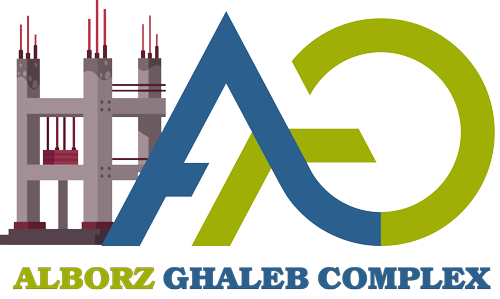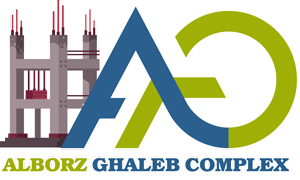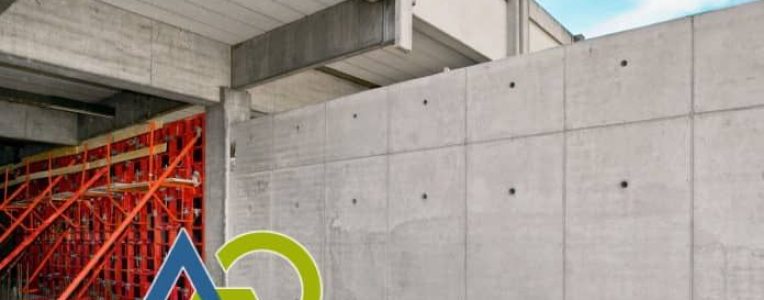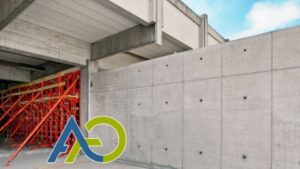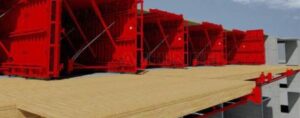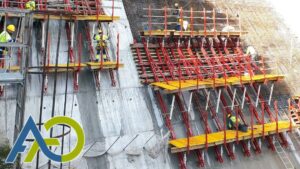Why Exposed Concrete Formwork is a Smart Choice for Modern Architecture
In the realm of modern architecture and construction, exposed concrete has emerged as a top choice for creating sleek, minimalist, and durable facades. Its smooth, polished surface and industrial aesthetic make it a favorite among architects and designers. However, achieving this level of quality and beauty relies on one critical tool: exposed concrete formwork. These molds not only ensure a flawless finish but also reduce project costs by up to 30% by eliminating the need for additional cladding materials like stone or tiles, while accelerating construction timelines.
Alborz Formwork, a leading manufacturer in Iran, leverages high-grade ST37 steel sheets and advanced technology to produce premium exposed concrete molds tailored to your project’s needs. This comprehensive guide explores everything you need to know about exposed concrete formwork: from its definition and history to benefits, technical specifications, installation processes, 2025 pricing, buying tips, and real-world case studies. If you’re seeking a modern, cost-effective, and sustainable solution for your construction projects, this article is your ultimate resource.
Ready to elevate your project to the next level? Contact Alborz Formwork: +98 912 139 0683
What is Exposed Concrete?
Definition and History
Exposed concrete, also known as architectural concrete, refers to concrete that serves as the final surface of a structure without requiring additional finishes like plaster, paint, or tiles. Its smooth, polished, or textured surface offers a modern, industrial aesthetic that enhances both structural and decorative elements. The use of exposed concrete dates back to the mid-20th century, with architects like Le Corbusier pioneering its application in iconic projects such as the Notre-Dame du Haut chapel (1955), where concrete was celebrated as a sculptural and aesthetic material.
Today, exposed concrete is widely used in diverse applications, including exterior facades of commercial and residential buildings, interior walls, urban furniture (benches, planters), and even interior decor elements like kitchen countertops and fireplaces. For a comparison with traditional formwork systems, explore our concrete formwork solutions.
Key Features of Exposed Concrete
Unlike standard concrete, exposed concrete requires a precise mix design to achieve its signature look and durability. Key features include:
- Type 2 Portland Cement: Minimizes cracking and enhances longevity.
- Superplasticizers: Improve workability and reduce air bubbles.
- Pigments: Enable a range of colors, from classic gray to white or custom shades.
- Low Water-Cement Ratio: Typically 0.35-0.4 for high compressive strength.
A sample mix design for exposed concrete: 400 kg cement, 1200 kg gravel, 600 kg sand, 180 liters water, and 2% superplasticizer by cement weight. This mix ensures a smooth, durable surface ideal for architectural applications.
What is Exposed Concrete Formwork?
Definition and Types
Exposed concrete formwork is a specialized system designed to shape concrete into smooth or patterned surfaces that serve as the final finish, eliminating the need for additional cladding. These molds are typically made from materials like steel, wood, or plastic, allowing for diverse textures and patterns. Unlike traditional formwork focused solely on structural integrity, exposed concrete molds also play an aesthetic role, creating visually striking surfaces.
Alborz Formwork offers a range of exposed concrete molds, including:
- Metal Formwork: Made from ST37 steel with a 3mm thickness, ideal for large-scale projects due to high durability.
- Plastic Formwork: Lightweight and cost-effective, perfect for intricate designs or smaller projects. Learn more about our plastic formwork systems.
- Wood Formwork: Used for unique, one-off patterns, though less durable and higher maintenance.
- Fiberglass Formwork: For highly complex designs, though less common due to higher costs.
Our versatile solutions cater to various project requirements, ensuring both functionality and aesthetics.
Exposed Concrete Formwork vs. Modular Formwork
Unlike modular formwork, which features smooth, standardized surfaces for general structural elements like walls and columns, exposed concrete formwork includes textured or polished surfaces that impart a decorative finish to the concrete. Modular formwork is suited for load-bearing structures, while exposed molds excel in architectural and decorative applications. For more details, check out our modular metal formwork.
Benefits of Exposed Concrete Formwork
Exposed concrete formwork offers a range of advantages, making it a preferred choice for contractors, architects, and designers:
- Cost Savings on Facades: Eliminates the need for expensive cladding materials like stone or tiles, reducing facade costs by up to 30%.
- Faster Construction: Quick assembly and disassembly of molds shorten project timelines.
- Reusability: Metal molds can be reused up to 50 times, plastic up to 30 times, lowering long-term costs.
- Design Versatility: Geometric, wood-like, or custom patterns enable unique facade designs.
- Durability: High resistance to concrete pressure and environmental factors like moisture and temperature changes.
- Sustainability: Reduces construction waste and allows for recyclable metal and plastic molds.
- Modern Aesthetic: Delivers an industrial, minimalist look that aligns with contemporary architectural trends.
These benefits make exposed concrete formwork ideal for residential, commercial, and public projects. To compare with other systems, explore our large panel formwork.
Technical Specifications of Exposed Concrete Formwork
Alborz Formwork’s exposed concrete molds are manufactured to international standards using high-quality materials. Key specifications include:
- Material: ST37 steel for metal molds, high-strength polymer for plastic molds.
- Sheet Thickness: 3mm for metal, 2-4mm for plastic.
- Standard Dimensions: 100×50 cm, 120×60 cm, 150×75 cm.
- Custom Dimensions: Tailored to project requirements with high precision.
- Surface Finish: Polished or textured (geometric, wood-like, or custom).
- Connections: Pins, wedges, clips, or bolts for fast, secure assembly.
- Weight: Metal molds ~20-30 kg, plastic molds ~5-10 kg.
- Load Capacity: Up to 60 kN/m² concrete pressure.
We use Mobarakeh Steel sheets, which offer superior quality and durability compared to other alternatives. For lightweight options, see our plastic formwork systems.
Designing Exposed Concrete Formwork: Key Considerations
Designing exposed concrete formwork requires careful attention to detail to achieve the desired aesthetic and structural outcomes. Key considerations include:
- Pattern Selection: From simple lines to complex geometric designs, patterns should align with the project’s architectural vision.
- Surface Texture: Smooth, rough, or wavy textures create different visual effects.
- Concrete Color: Pigments can add variety, from classic gray to vibrant hues.
- Defect Prevention: High-quality molds and concrete (C30 or C40) minimize cracks and imperfections.
Our experts at Alborz Formwork can assist in designing custom molds tailored to your project. For intricate designs, consider our plastic formwork systems.
How to Install Exposed Concrete Formwork
In-Situ Installation Process
Installing exposed concrete formwork demands precision in mold selection, preparation, and concrete pouring. The main steps are:
- Mold Preparation: Clean the mold surface and apply a water-based release agent to prevent concrete adhesion.
- Mold Assembly: Secure molds using pins, wedges, or clips, ensuring perfect alignment.
- Reinforcement: Place rebar and spacers per structural designs.
- Concrete Pouring: Use a mix with 400 kg cement, 180 liters water, and 2% superplasticizer.
- Vibration: Apply electric or mechanical vibrators to eliminate air bubbles and compact the concrete.
- Initial Setting: Allow 24-48 hours for concrete to set, depending on temperature and humidity.
- Curing: Keep the concrete moist for 7-14 days to ensure strength and prevent cracking.
- Mold Removal: Disassemble molds carefully to preserve the smooth surface.
- Finishing: Wash the surface or apply a protective sealer to enhance durability.
For large-scale projects, complement your setup with our tunnel formwork.
Precast vs. In-Situ Installation
Exposed concrete can be executed in two ways:
- In-Situ: Concrete is poured directly into molds at the project site, ideal for large walls, continuous facades, or complex structures.
- Precast: Concrete panels are produced in a factory and transported to the site, suitable for smaller, repetitive, or time-sensitive projects.
Alborz Formwork provides both in-situ and precast molds with high precision. Learn more about our modular metal formwork.
Tips for Successful Installation
To achieve a flawless finish, consider these tips:
- Concrete Quality: Use concrete with a minimum compressive strength of 30 MPa.
- Proper Vibration: Avoid over-vibration to prevent aggregate segregation.
- Ambient Temperature: Pour concrete at 15-25°C to minimize cracking.
- Mold Cleanliness: Remove debris to maintain surface quality.
For lightweight molds, explore our plastic formwork systems.
Maintaining and Repairing Exposed Concrete Formwork
Regular maintenance extends the lifespan of exposed concrete molds:
- Cleaning: Wash molds with water and a brush after each use.
- Stain Removal: Use mild detergents to remove concrete residue.
- Storage: Store molds in a dry, moisture-free environment.
- Repairs: Weld cracks in metal molds or use resin for plastic molds.
Plastic molds are easier to maintain due to their lightweight nature. See our plastic formwork systems.
Exposed Concrete Formwork Price in 2025
The cost of exposed concrete formwork depends on several factors:
- Mold Size: Larger molds are more expensive.
- Material: Metal molds cost more than plastic.
- Sheet Quality: Mobarakeh Steel vs. other suppliers.
- Market Fluctuations: Steel and raw material prices.
- Surface Design: Custom patterns increase costs.
Case Studies: Successful Projects with Exposed Concrete
Alborz Formwork has delivered exposed concrete solutions for numerous projects:
- Tehran Residential Towers: Smooth, textured concrete facades using our metal molds.
- Karkheh Dam: Durable, aesthetic concrete surfaces for infrastructure.
For similar large-scale applications, explore our large panel formwork.

Tips for Buying Exposed Concrete Formwork
When selecting exposed concrete formwork, consider these factors:
- Material Quality: Opt for ST37/ST52 steel or high-grade polymers.
- Manufacturing Precision: Molds should be seamless and defect-free.
- Design Compatibility: Ensure molds align with your project’s aesthetic and structural needs.
- Customization: Ability to create unique patterns.
- Connections: High-quality pins, wedges, or clips for secure assembly.
- Supplier Reliability: Alborz Formwork offers proven expertise and support.
- After-Sales Support: Look for warranties and technical assistance.
- Cost vs. Quality: Balance price with durability and performance.
Alborz Formwork provides tailored solutions and professional support. For cost-effective options, see our plastic formwork systems.
Why Choose Alborz Formwork for Exposed Concrete Molds?
Alborz Formwork stands out as a trusted partner for contractors, architects, and designers:
- Unmatched Quality: ST37/ST52 steel molds with precision manufacturing and international standards.
- Custom Solutions: Molds designed to your specifications with fast delivery.
- Competitive Pricing: High-quality molds at affordable rates.
- Expert Support: Free technical consultation and after-sales service.
- Product Variety: From metal to plastic molds, catering to all project types. Explore our metal formwork
Partner with Alborz Formwork to ensure your projects deliver on quality and innovation. Contact Us Now: +98 912 139 0683
Frequently Asked Questions About Exposed Concrete Formwork
1. What’s the difference between exposed concrete formwork and modular formwork?
Exposed concrete molds feature textured or polished surfaces for decorative finishes, while modular formwork has smooth surfaces for structural elements. See our modular formwork.
2. Are exposed concrete molds reusable?
Yes, metal molds can be reused up to 50 times, and plastic molds up to 30 times with proper maintenance.
3. What concrete is best for exposed finishes?
Concrete with a low water-cement ratio (0.35-0.4), Type 2 cement, and superplasticizers ensures a smooth, durable surface.
4. How can I get a quote for exposed concrete formwork3
Contact us at +98 912 139 0683 for accurate, up-to-date pricing.
5. Is exposed concrete formwork suitable?
Yes, lightweight plastic molds are are ideal for smaller projects. Check out our plastic-formwork systems.
6. When should I use precast concrete molds?
Precast molds are ideal for small, repetitive, or time-constrained projects, with panels produced off-site.
Conclusion: Transform Your Projects with Alborz Formwork
Exposed concrete formwork modern, is cost-effective, a sustainable and solution modern for creating flawless architectural concrete surfaces. By reducing costs, speeding up construction, offering design versatility, and ensuring durability, these molds are a game-changer for modern projects. Alborz Formwork, with high-quality metal and plastic molds, expert support, and competitive pricing, is your trusted partner for success.
